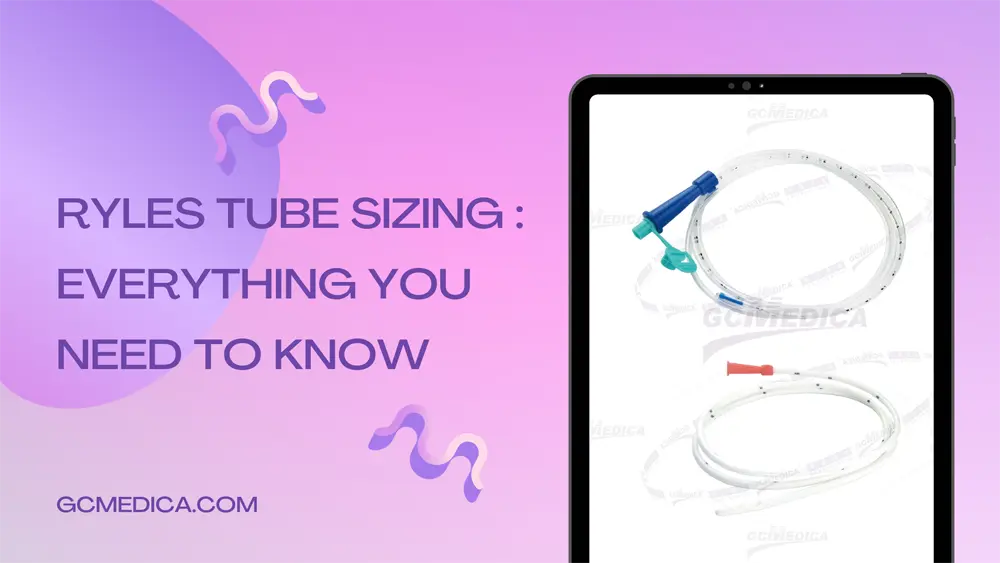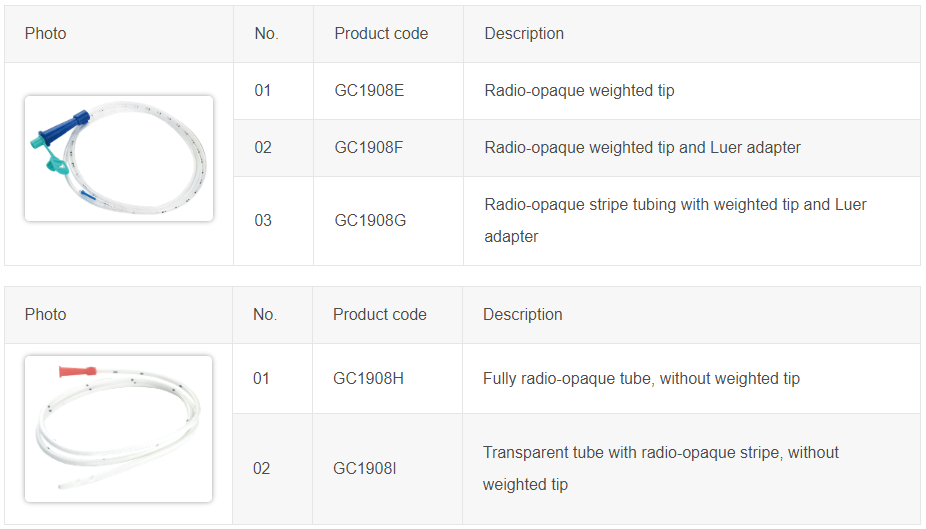Ryles Tube Sizes : Everything You Need to Know

Introduction to Ryles Tubes: Explaining What Ryles Tubes Are and Their Medical Significance
Ryles tubes, commonly known as nasogastric tubes, play a pivotal role in medical care, offering a practical solution for feeding, administering medication, and gastric decompression. Named after their inventor, Dr. Thomas Ryle, these flexible tubes are inserted through the nose, down the throat, and into the stomach. Their design and application have evolved over the years, making them an indispensable tool in both acute and chronic care settings.
The significance of Ryles tubes in medical practice cannot be overstated. They are used in various situations, from aiding patients with difficulty swallowing to providing nutritional support for those unable to eat orally. Their versatility extends to diagnostic purposes, such as extracting stomach contents for analysis, and therapeutic uses, like removing excess air or harmful substances from the stomach.
Given their critical role in patient care, understanding the sizing of Ryles tubes is essential for healthcare professionals. The correct size ensures maximum effectiveness and minimizes potential complications. This article delves into the intricacies of Ryles tube sizes, providing valuable insights for making informed decisions in clinical settings. By exploring the range of available sizes and their specific applications, we aim to equip medical practitioners with the knowledge necessary for optimizing patient care through appropriate Ryles tube selection.
Understanding Different Sizes of Ryles Tubes: A Detailed Look
Ryles tubes come in a range of sizes, each suited for specific medical purposes. The size of a Ryles tube is crucial for its intended use, and selecting the wrong size can lead to ineffective treatment or complications. The sizes are generally measured in French units (Fr), where one French unit equals one-third of a millimeter in diameter.
Neonatal and Pediatric Use: For neonates and small children, smaller sizes ranging from 5 Fr to 8 Fr are commonly used. These sizes are ideal for minimizing discomfort and ensuring safety in a smaller anatomy.
Adult Use: In adults, the sizes vary more widely, typically ranging from 10 Fr to 18 Fr. Larger tubes, like 16 Fr or 18 Fr, are often used for gastric decompression or lavage, as they can effectively remove large volumes of gastric contents. On the other hand, sizes like 10 Fr to 12 Fr are more commonly used for feeding and medication administration.
Specialized Sizes: Certain clinical situations might demand specialized sizes. For instance, a patient with a narrowed esophageal passage might require a smaller tube, regardless of their age or size.
Size Selection Considerations: The choice of size is influenced by factors like the patient's age, anatomy, the purpose of the tube (feeding, medication, decompression), and the viscosity of the content to be passed through the tube. A balance must be struck between efficacy and patient comfort.
Clinical Implications of Size Selection: Using a tube that is too small might lead to frequent blockages and inadequate therapy, while a tube that is too large can cause discomfort and potential trauma to the nasal, throat, and gastric tissues.

Understanding the nuances of Ryles tube sizing is vital for effective patient care. It requires a blend of clinical knowledge, consideration of patient-specific factors, and an understanding of the intended use of the tube.
Factors Influencing the Choice of Size in Ryles Tubes
Selecting the appropriate size of a Ryles tube is a decision that hinges on multiple patient-specific factors. Understanding these factors is key to ensuring both the effectiveness of the tube's purpose and the patient's comfort.
Patient's Age and Size: The most immediate consideration is the age and physical size of the patient. Neonates, infants, and children require significantly smaller sizes than adults.
Medical Condition and Purpose: The specific medical condition being treated plays a crucial role in determining the size. For instance, larger tubes may be necessary for gastric decompression in cases of bowel obstruction, while smaller tubes might be sufficient for routine feeding and medication administration.
Anatomical Considerations: Anatomical variations, such as a narrow esophagus or a history of throat surgeries, can dictate the need for smaller or more flexible tubes to prevent injury and ensure comfortable placement.
Duration of Use: Short-term versus long-term use also influences size selection. For long-term use, comfort and minimizing tissue irritation become more significant considerations.
Viscosity of Contents: The viscosity of the material to be administered through the tube (e.g., liquid nutrition, medication) affects size choice. Thicker substances may require a larger bore tube to avoid clogging.

Insertion and Maintenance of Different Sized Ryles Tubes
The insertion and ongoing maintenance of Ryles tubes vary depending on their size, which in turn impacts their purpose and the patient's comfort. This section covers key considerations for the safe insertion and effective maintenance of Ryles tubes of different sizes.
Insertion Techniques
1.Preparation: Prior to insertion, the appropriate size is chosen based on patient assessment. The nostril that appears to be the most patent (open) is typically selected for insertion.
2.Insertion Method: The method of insertion can differ slightly based on the size of the tube. Larger tubes, being stiffer, might require more careful navigation through the nasal passage, while smaller tubes might be easier to insert but require more precision to ensure correct placement.
3.Confirmation of Placement: Once inserted, the placement of the tube must be confirmed, usually by X-ray, to ensure that it has reached the stomach and not deviated into the respiratory tract.
Maintenance Practices
1.Monitoring for Blockages: Smaller tubes are more prone to blockages and require regular monitoring to ensure they remain patent and functional.
2.Regular Flushing: All sizes of Ryles tubes should be regularly flushed to maintain patency and prevent buildup of material within the tube.
3.Patient Comfort and Safety: Regular assessment of the insertion site, nasal and throat condition, and overall patient comfort is crucial, especially for long-term use. Adjustments may be necessary if irritation or complications arise.
Special Considerations
In Pediatric Patients: Extra care is needed when inserting and maintaining tubes in neonates and children due to their smaller anatomy and the potential for quicker onset of complications.
Common Challenges and Solutions Related to Ryles Tube Sizing
Working with Ryles tubes presents a set of challenges, particularly when it comes to sizing. Understanding these challenges and knowing the solutions can greatly enhance patient care.
| Challenge 1: Incorrect Sizing | Problem | Choosing a tube that is either too large or too small for the patient can lead to complications such as discomfort, injury, or ineffective treatment. |
| Solution | Comprehensive patient assessment and understanding the intended use of the tube are crucial. In cases of uncertainty, consult with more experienced colleagues or consider using adjustable-length tubes. | |
| Challenge 2: Patient Discomfort | Problem | Especially with larger sizes, patients may experience discomfort or nasal and throat irritation. |
| Solution | Regular monitoring and using lubricants during insertion can help. If discomfort persists, re-evaluating the size or style of the tube may be necessary. | |
| Challenge 3: Tube Blockage | Problem | Smaller tubes are prone to blockage, which can impede treatment. |
| Solution | Regular flushing and monitoring of the tube, along with ensuring that the contents are of appropriate viscosity, can prevent blockages. | |
| Challenge 4: Long-term Use Complications | Problem | For patients requiring long-term use, issues like tissue irritation, infection, or displacement of the tube can arise. |
| Solution | Regular reassessment of the tube’s position and condition, along with patient education on how to manage the tube at home, is vital. | |
| Challenge 5: Emergency Situations | Problem | In emergencies, quick and accurate sizing is crucial but can be challenging. |
| Solution | Training and preparedness, along with having a range of tube sizes readily available, can aid in making quick and accurate decisions in emergency scenarios. |
Conclusion: Optimizing Patient Care with the Right Ryles Tube Size
The journey through the world of Ryles tubes emphasizes the importance of correct sizing in medical treatment. From neonatal care to adult emergency interventions, the appropriate selection and use of Ryles tubes can significantly impact patient outcomes. This article has highlighted the various sizes of Ryles tubes, factors influencing size selection, insertion and maintenance techniques, and common challenges with practical solutions.
The key takeaway is that the correct sizing of Ryles tubes is not just a matter of medical protocol, but a critical aspect of patient-centered care. Healthcare professionals must balance clinical guidelines with individual patient needs to ensure the best outcomes. Regular training, staying updated with the latest practices, and a deep understanding of patient care dynamics are essential for effective use of Ryles tubes.

